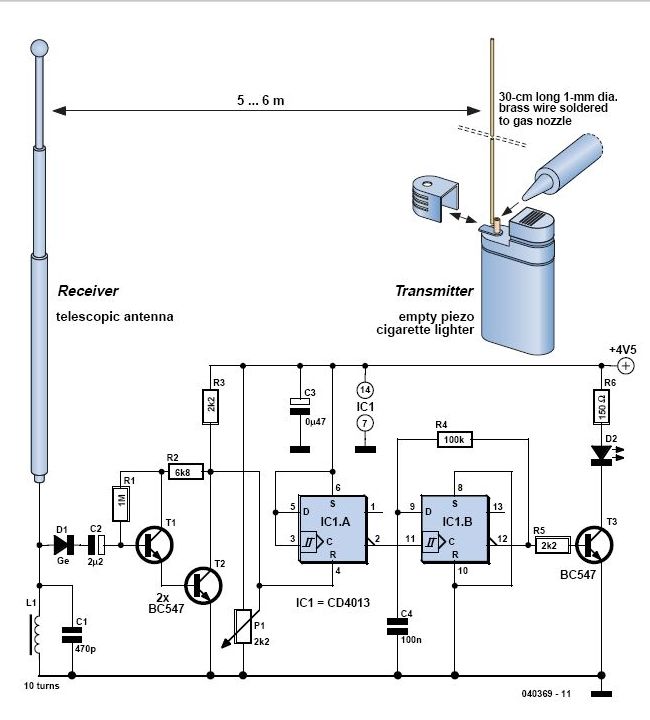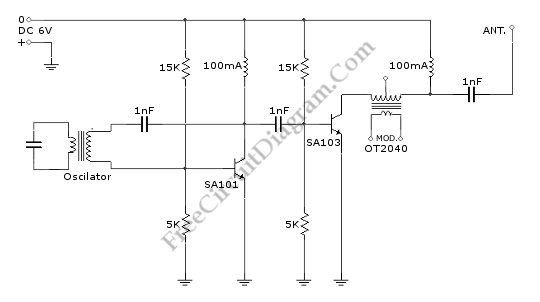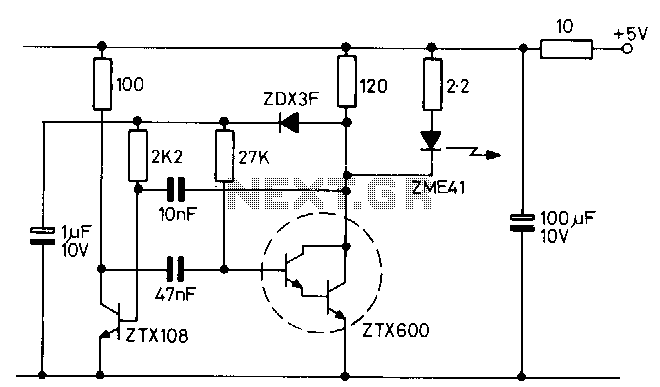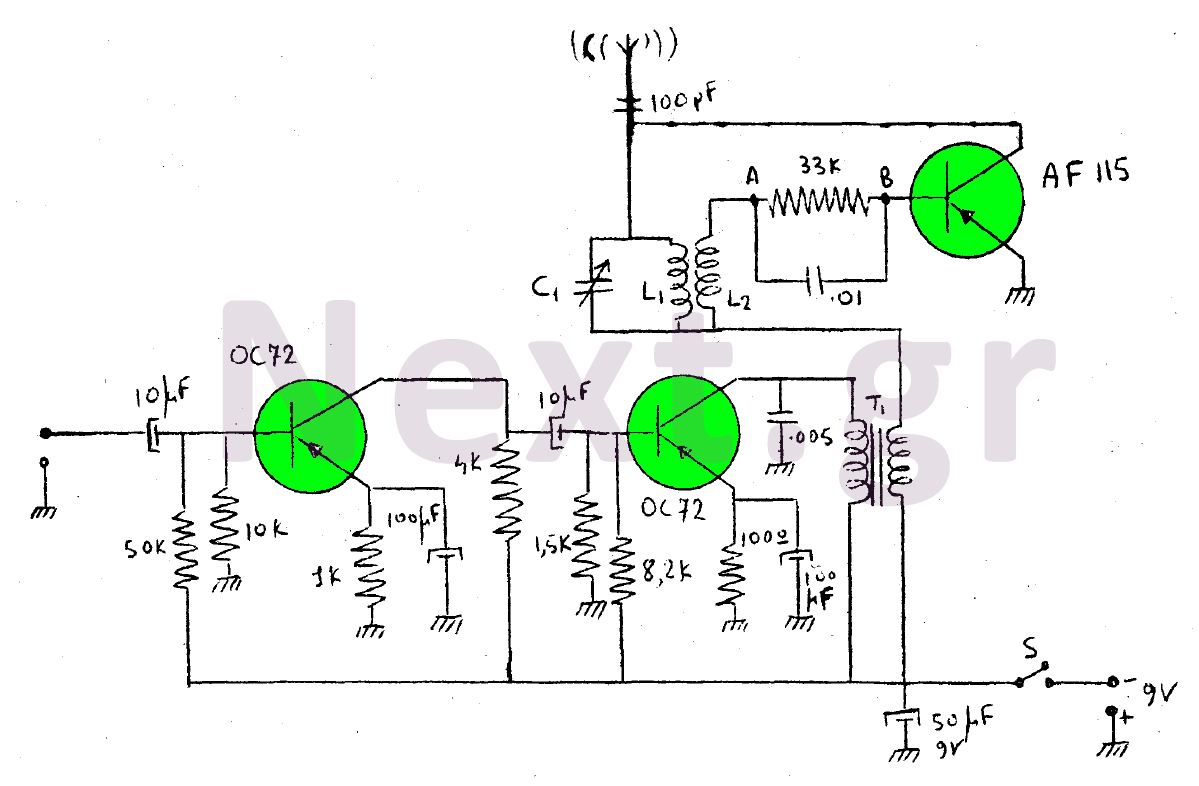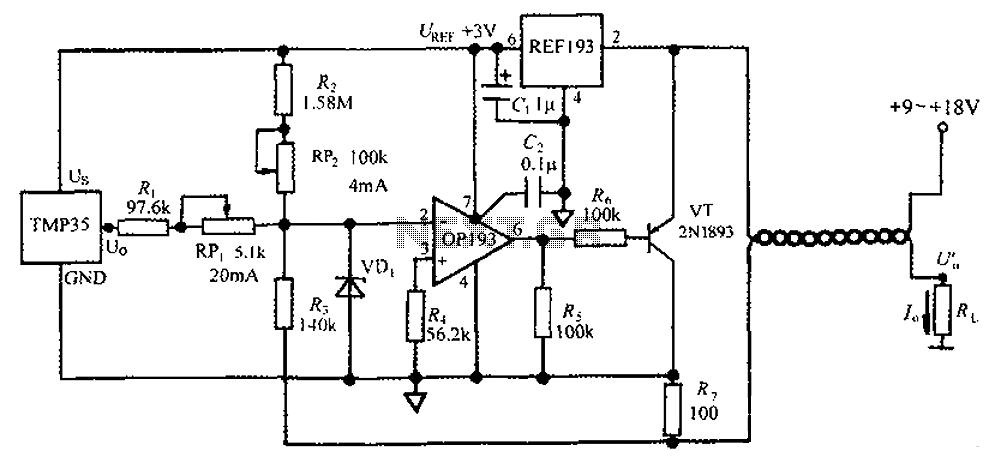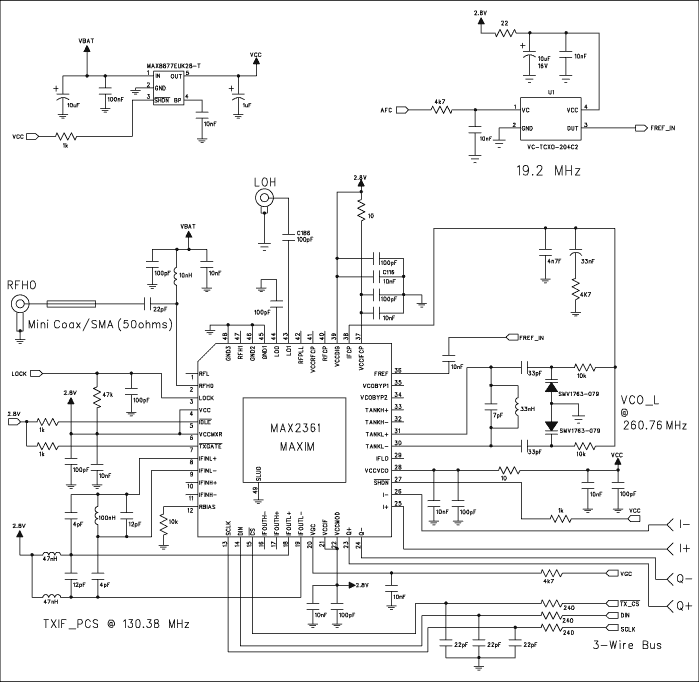
TX-300 300mW FM Transmitter
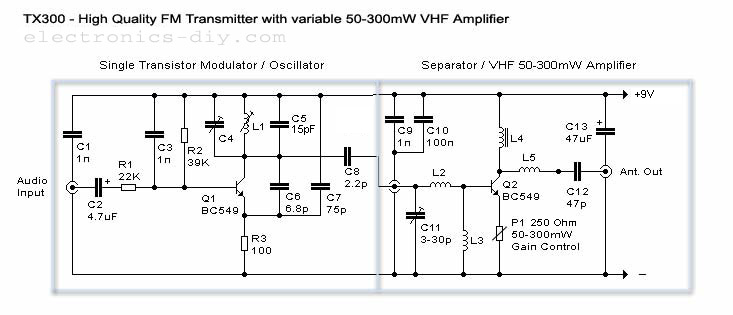
The amplifier features the same architecture as the TX500, but the TX300 is equipped with a single-stage variable VHF amplifier. This schematic is designed for those seeking a simpler alternative to the TX500, requiring fewer components. It is an ideal circuit for transmitting music throughout a home or yard. An interesting feature is the gain control (P1), which allows for adjustment of the output power and transmission distance. If a more powerful transistor, such as the 2N4427 or 2N3866, is used to replace Q2, P1 must be substituted with a resistor to accommodate the increased current requirements. For more information, refer to the TX500 page.
The TX300 amplifier circuit is designed as a compact VHF transmitter, suitable for personal audio applications. It utilizes a single-stage amplifier configuration, which simplifies the design while maintaining effective performance. The primary component of the circuit is the variable gain control (P1), which enables users to modulate the output power based on their specific needs. This feature is particularly useful for optimizing transmission range, allowing the user to achieve the desired coverage area without excessive power consumption.
The circuit's architecture is built around a basic transistor amplifier setup, where Q2 serves as the main amplification element. The choice of transistor plays a critical role in the performance of the amplifier. Substituting Q2 with a higher-rated transistor, such as the 2N4427 or 2N3866, enhances the amplifier's output capabilities. However, this modification necessitates the adjustment of P1, replacing it with a resistor to ensure the circuit can handle the increased current draw without compromising stability or performance.
Additionally, the simplicity of the TX300 circuit makes it an excellent choice for hobbyists and DIY enthusiasts interested in building their own FM transmitter. The reduced number of components not only streamlines the assembly process but also minimizes potential points of failure, contributing to the overall reliability of the circuit. The schematic is designed to be accessible, providing a straightforward pathway for users to create a functional and effective audio transmission solution.
Overall, the TX300 amplifier circuit represents a practical and efficient design for transmitting audio wirelessly, making it suitable for various applications where simplicity and effectiveness are paramount.The amplifier has exactly the same architecture as TX500 with the difference that TX300 has only one stage variable VHF amplifier. It is a cute schematic that was made for all of you who wanted something even simpler than TX500 and with not as many necessary parts.
It is a perfect circuit for transmitting your music around the house and yard. Inte resting feature is a gain control P1 that lets you adjust your desired output power and distance. If in case you want to replace Q2 with more powerful transmitter like 2n4427 or 2n3866 you will have to replace P1 with a resistor due to the higher necessary current. For much more info go to TX500`s page. fm transmitters stereo encoders electronic encoder free schematics circuits diagrams electronics kits electronic projects diy telephone bugs amplifiers pre-amplifiers power supply supplies fm radio receivers 2n4427 2n3866 integrated circuits elektonika schematy zestawy elektroniczne nadajniki fm odbiorniki wzmacniacze predwzmacniacze enkodery dekodery stereo przystawki telefoniczne telefoniczny czesci elektroniczne mierniki cyfrowe fm transmitters stereo encoders electronic encoder free schematics circuits diagrams electronics kits electronic projects diy telephone bugs amplifiers pre-amplifiers power supply supplies fm radio receivers 2n4427 2n3866 integrated circuits elektonika schematy zestawy elektroniczne nadajniki fm odbiorniki wzmacniacze predwzmacniacze enkodery dekodery stereo przystawki telefoniczne telefoniczny czesci elektroniczne mierniki cyfrowe heatsinks large heatsinks extruded heatsinks extrusion heatsink amplifier heatsinks large heatsink aluminum heatsinks large aluminum extruded heatsinks large heat sinks heat sink aluminum heatt sinks
🔗 External reference
The TX300 amplifier circuit is designed as a compact VHF transmitter, suitable for personal audio applications. It utilizes a single-stage amplifier configuration, which simplifies the design while maintaining effective performance. The primary component of the circuit is the variable gain control (P1), which enables users to modulate the output power based on their specific needs. This feature is particularly useful for optimizing transmission range, allowing the user to achieve the desired coverage area without excessive power consumption.
The circuit's architecture is built around a basic transistor amplifier setup, where Q2 serves as the main amplification element. The choice of transistor plays a critical role in the performance of the amplifier. Substituting Q2 with a higher-rated transistor, such as the 2N4427 or 2N3866, enhances the amplifier's output capabilities. However, this modification necessitates the adjustment of P1, replacing it with a resistor to ensure the circuit can handle the increased current draw without compromising stability or performance.
Additionally, the simplicity of the TX300 circuit makes it an excellent choice for hobbyists and DIY enthusiasts interested in building their own FM transmitter. The reduced number of components not only streamlines the assembly process but also minimizes potential points of failure, contributing to the overall reliability of the circuit. The schematic is designed to be accessible, providing a straightforward pathway for users to create a functional and effective audio transmission solution.
Overall, the TX300 amplifier circuit represents a practical and efficient design for transmitting audio wirelessly, making it suitable for various applications where simplicity and effectiveness are paramount.The amplifier has exactly the same architecture as TX500 with the difference that TX300 has only one stage variable VHF amplifier. It is a cute schematic that was made for all of you who wanted something even simpler than TX500 and with not as many necessary parts.
It is a perfect circuit for transmitting your music around the house and yard. Inte resting feature is a gain control P1 that lets you adjust your desired output power and distance. If in case you want to replace Q2 with more powerful transmitter like 2n4427 or 2n3866 you will have to replace P1 with a resistor due to the higher necessary current. For much more info go to TX500`s page. fm transmitters stereo encoders electronic encoder free schematics circuits diagrams electronics kits electronic projects diy telephone bugs amplifiers pre-amplifiers power supply supplies fm radio receivers 2n4427 2n3866 integrated circuits elektonika schematy zestawy elektroniczne nadajniki fm odbiorniki wzmacniacze predwzmacniacze enkodery dekodery stereo przystawki telefoniczne telefoniczny czesci elektroniczne mierniki cyfrowe fm transmitters stereo encoders electronic encoder free schematics circuits diagrams electronics kits electronic projects diy telephone bugs amplifiers pre-amplifiers power supply supplies fm radio receivers 2n4427 2n3866 integrated circuits elektonika schematy zestawy elektroniczne nadajniki fm odbiorniki wzmacniacze predwzmacniacze enkodery dekodery stereo przystawki telefoniczne telefoniczny czesci elektroniczne mierniki cyfrowe heatsinks large heatsinks extruded heatsinks extrusion heatsink amplifier heatsinks large heatsink aluminum heatsinks large aluminum extruded heatsinks large heat sinks heat sink aluminum heatt sinks
🔗 External reference
